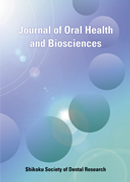Volume 30, Issue 1
Displaying 1-6 of 6 articles from this issue
- |<
- <
- 1
- >
- >|
-
2017 Volume 30 Issue 1 Pages 1-7
Published: 2017
Released on J-STAGE: June 30, 2017
Download PDF (1039K) -
2017 Volume 30 Issue 1 Pages 8-17
Published: 2017
Released on J-STAGE: June 30, 2017
Download PDF (2127K) -
2017 Volume 30 Issue 1 Pages 18-25
Published: 2017
Released on J-STAGE: June 30, 2017
Download PDF (1498K) -
2017 Volume 30 Issue 1 Pages 26-32
Published: 2017
Released on J-STAGE: June 30, 2017
Download PDF (5091K)
-
2017 Volume 30 Issue 1 Pages 33-39
Published: 2017
Released on J-STAGE: June 30, 2017
Download PDF (1513K)
-
2017 Volume 30 Issue 1 Pages 40-44
Published: 2017
Released on J-STAGE: June 30, 2017
Download PDF (783K)
- |<
- <
- 1
- >
- >|
